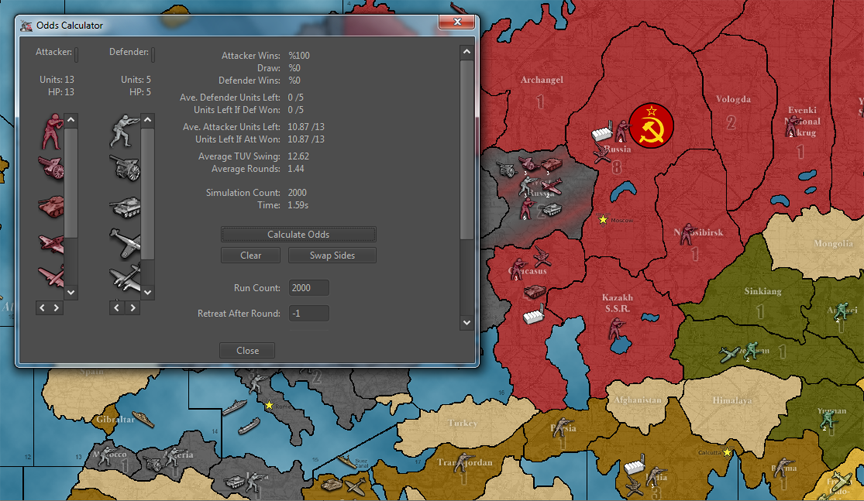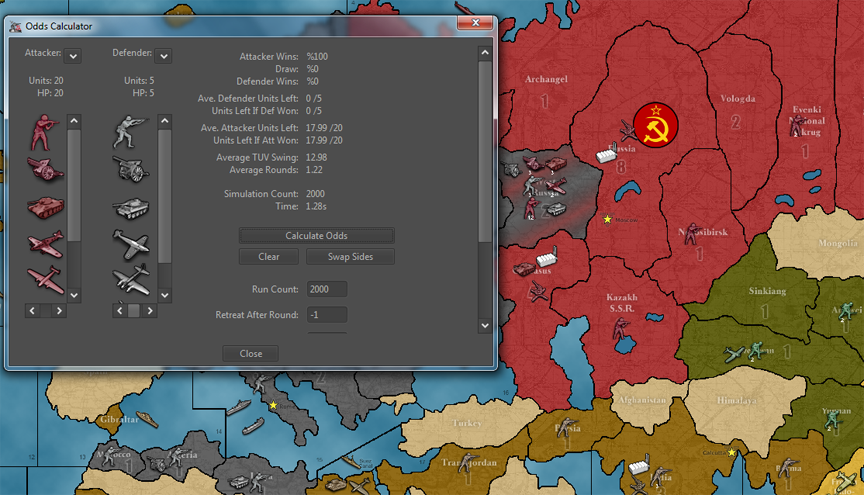It’s true, the two minor factories still serve as a Russian Achilles heal, and like you, when I tested it, Japan gunned for Kazakh (which is my usual 1942.2 attack route for Japan anyway), but the advantage for Russia is that it stretches the German logistics. So Russia can trade with less fear of G immediately stacking the captured factories. Kazakh is kind of interesting too because Indian tanks can reach it in 1 move, and bombers from UK can likewise reach it in 1 move. It’s also possible for the Soviets to put more pressure on Japan in the first round, since Russian tanks built here can reach Kwang on the blitz, while still covering W. Russia or Ukraine. This advantage diminished with each round that elapses, since Japan can shuck so easy, but it might be fun for teasing out new round 1 plays vs Japan. The Kazakh factory is also a permanent blocker, which can come in handy if getting pressed by Japanese tanks and you need to do a full evac.
It took me a while to realize how important Kazakh is to the Russian position at the center in 1942.2, (the China design is different from earlier A&A boards where this territory, while important, was somewhat less critical in Classic or Revised.) Often in 1942.2 I’ve seen the Russian player let Japan snag it uncontested, which invariably causes the center to fold faster than it might otherwise. The sz61 push to Yunnan allows the Japanese to reach Kazakh very quickly with reinforcements from the home island, and a Japanese held Kazakh is usually in range of German air too, which means that sometimes the Allied player gets tripped up here. They will pull out of Kazakh thinking they can trade the territory with ease, only to get caught with their pants down and lose it permanently to Axis, with no real chance of recovery, as Japan just keeps funneling ground there each round. Here the proposed starting factory draws a big red bulls eye on the territory, making it pretty clear to both sides, that this territory should not be given up without a fight.
:-D
Also, by removing the Caucasus factory, you really alter the German player’s priorities at the center of the gameboard. They can still park units in Caucasus or Karelia to threaten the center, but they can’t reinforce that stack as easily, which makes the move somewhat less attractive. I rather envision that the trading which occurs in Caucasus and Karelia between G and Russia, is like the Siege of Leningrad or the battle of Stalingrad, with control shifting back and forth, ownership representing when one side or the other has gained the upper hand, but without allowing for immediate spams of infantry. Instead ground has to be moved into the city first haha.
Vologda is less useful, of course, but it can help to control the north vs an Axis link up, and gives you a but more reach into the Soviet Far east. Its hard to justify building units here at the outset, but this factory is 1 space closer to Japan, so perhaps useful in a KJF type scenario where you want to hold the north against an early blast, or rush some defenders towards the far East, so you don’t have to watch all that red land turn yellow with no contest.
Archangel is an interesting alternative candidate. It’s only worth 1 ipc on this map, which would be somewhat limiting for Russia, though also limiting for Axis when captured, and it would be a permanent blocker. I like the concept of 1 ipc factories, though I get the impression others might feel that 1 ipc is too low for a starting factory on this board.
Kazakh and Vologda aren’t quite perfect, but I find that the Russians can be pretty effective out of Moscow, if they don’t have to worry as much about Germany stacking Caucasus with a free factory. Now if G wants to build out of Karelia or Caucasus they’d have to spend 15 ipcs first and face a one round delay, which can make a big difference at about round 6 or 7 when Axis can usually stack the south with ease. Less pressure for UK in India, can also help free up British units to cover Suez or the Russian capital, if Japan goes balls out against China.
I agree with you about sz37, the set up there is a bit odd. I suppose there is nothing to prevent you from giving the Russians the extra bomber too, in addition to the factory change, if it seems like the Soviets are still too weak.
:-D
I posted the factory change idea with a gamesave in the HR section, in case anyone wants to try it.
http://www.axisandallies.org/forums/index.php?topic=36172.0
Part of the reason I like this tweak, is because it encourages to the Russian player to actually fight against Japan, instead of just ceding control of the East as soon as Japan arrives. Kazakh is not quite as hard to stack/hold as might seem to be the case at the outset. After a few rounds of building, even Evenki and Yakut can hold, provided you’re willing to trade a bit against Japan early on. I think the issue OOB is that Russia is under huge pressure to stay fixated on Karelia and Caucasus for fear of early German stacking, which means they have basically no free units/opportunities to send against Japan. The challenge I think, under the set up I proposed, is that the lack of a starting Factory in Caucasus (no permanent blocker there) changes the way the Allies can “can-open” at the center. You have to be more on guard against a potential Axis blitz route, and remember to leave a blocking unit if you pull out of the territory as Russia, since the factory is not their to serve this function.
I think there are some other potential factories tweaks you could make too, if you don’t like the Vologda/Kazakh idea.
One solution might be to move the starting factory in Karelia to W. Russia (German occupied at the outset, but easy for the Soviets to recover on R1) and just keep the Caucasus factory in place. This does the double duty, of denying Germany their easy Lendingrad factory capture, while giving the Russians +2 production in a critical space. The danger there is of Germany taking and stacking W. Russia right next to Moscow, but that just means that the factory can still serve as a swing territory available to either side over the course of play.
Another idea suggest above is to move the Karelia factory to safe territory that is only worth 1 ipc, to make it less valuable as a target. Arch, Evenki, or Novos could be interesting.
This stuff is of course all just musing on bid alternatives, and not necessary for beginners. But I think its fun to have some suggestions for different ideas to try, when the game gets a bit old, and you want to attempt something new on your 1942.2 board.
My favorite tweak is probably still just the Russian bomber at Moscow, if you need a quick fix. I like how the sculpt is so damned huge!
Also, it’s not inconceivable, that, when provided with an extra bomber from the outset, the Russian player might even get to point where they decide “Well, ����-it! I’m just going to buy second big bomber!” Drop 12 ipcs just the one time, to unleash the dread Red Air armada haha! A pair of fighters, and pair of bombers! The double duo in the skies! A death defying dual with Germany in the light trading game. Plus you get some extra reach on the air evac, in case Stalin has to fly away during the endgame heheh.
:-D







